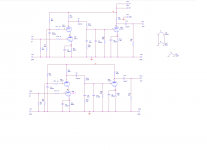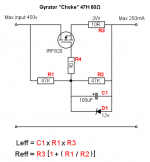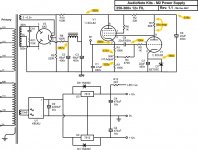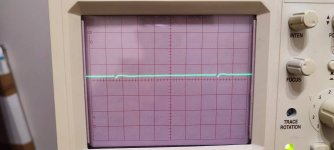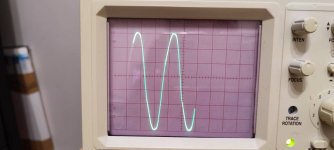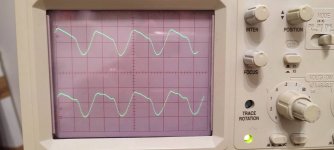Hello everyone, I bought some pcb to build a phono of audio note kit, I assembled everything tested and it is here with me that it sounds great, I have only a small problem, at the volume setting of my pre I hear a hum, which goes increasing with the volume, I used shielded cables, and separate transformer for the filaments.I use a gyrator instead of the inductor. I am attaching the schematic so that I can comment better.
Attachments
How can I measure it? I only have an oscilloscope with a 10x probeMeasure the ripple on the B+ supply. Is the noise 50/60Hz, or 100/120Hz?
If your scope input is rated for at least 500VDC, just set it to AC Volts.
Set the scope input to AC Volts and 1V/division to start.
If the scope is not rated for 500VDC, make a x100 attenuator with resistors connected to the supply:
B+ to 1M to 10k to ground, and measure the 10k voltage. Set the scope to AC Volts, 1V/division to start.
Set the scope input to AC Volts and 1V/division to start.
If the scope is not rated for 500VDC, make a x100 attenuator with resistors connected to the supply:
B+ to 1M to 10k to ground, and measure the 10k voltage. Set the scope to AC Volts, 1V/division to start.
Last edited:
Tomorrow I should have a 100x probe. If I can't find it I will use the resistors as described in the previous post and share the results
To start with, set the the scope inputs on AC Volts, and the vertical V/DIV at the maximum, maybe 50V/DIV. Then increase sensitivity while checking the waveform.
Member
Joined 2009
Paid Member
Maybe try grounding the input, just in case it's being picked up right at the input which is a sensitive node in the circuit.
Then set the scope for x1, adjust the vertical amplitude so the noise is at least four divisions high,
and calculate the ripple. It will be x100 of what the vertical setting says.
and calculate the ripple. It will be x100 of what the vertical setting says.
Set the scope input to AC volts only (not DC volts), and adjust the horizontal line to the vertical center
of the screen. Then connect the probe to the circuit. The probe ground must be connected to the circuit ground,
or you will only see a large 60Hz sine wave.
of the screen. Then connect the probe to the circuit. The probe ground must be connected to the circuit ground,
or you will only see a large 60Hz sine wave.
After some break for work I went back to work on this phono, I read from who built this phono that it is silent and you can't hear anything from the speakers, so it's a matter of principle and I would like to be able to locate the problem, I connected the power output to the oscilloscope with a 100x probe, the ground is connected to the frame, and here's what I see, the oscilloscope is so set up, volts / div = 0.1V, time / div = 5mS, it could be useful in the intercept the problem?
Attachments
Is the phonostage objectionaby noisy in. Operation?
Every builder, home commercial or otherwise claims their phono stage is silent. Haven't found that to be the case yet in 20 years messing with phono stages. They are never silent, cant be.
If you can get it to idle as quiet as a commercial unit, you are doing pretty good.
Someone who says they have a silent phono stage, is like someone saying they've never piked their nose.
Sounds great, but it isnt true.
Every builder, home commercial or otherwise claims their phono stage is silent. Haven't found that to be the case yet in 20 years messing with phono stages. They are never silent, cant be.
If you can get it to idle as quiet as a commercial unit, you are doing pretty good.
Someone who says they have a silent phono stage, is like someone saying they've never piked their nose.
Sounds great, but it isnt true.
- Home
- Source & Line
- Analog Line Level
- Audio note kit l3 phono
